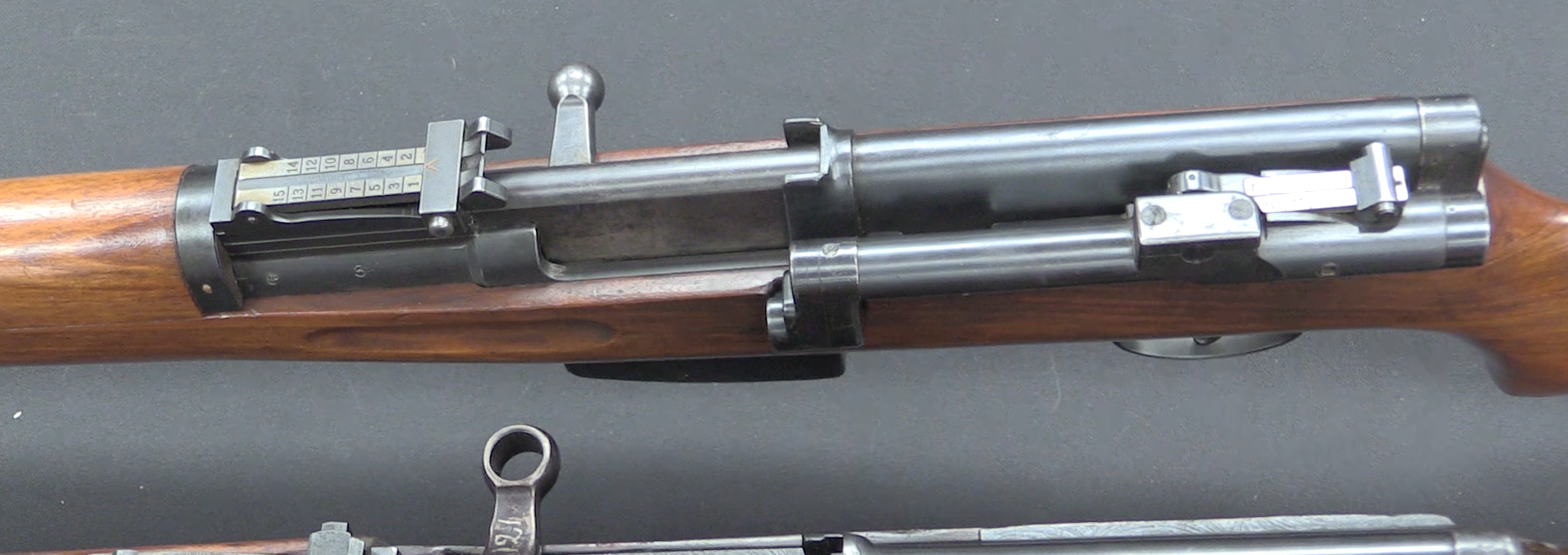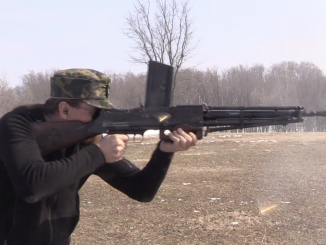The Reibel Modele M31 was the variation of the French Chatellerault M24/29 light machine gun made for use in vehicles and fortifications. In accordance with that role, it lacked a buttstock or sights (these were integrated into the vehicle or fortress mounts), was fitted with a very heavy barrel for sustained fire, and fed from a massive 150-round drum magazine. These were often used in dual mounts, with one left-hand and one right-hand feed gun (note that the bolt is easily swapped for feed from either side).
After World War Two, the Swiss purchased a number of these guns form France, rechambered them for the 7.5x55mm Swiss cartridge, and fitted them in AMX tanks. This particular gun is one of those, and it is mounted on a Swiss LMG-25 tripod using an adapter designed for gunsmith test firing outside the tank.
Thanks to the Kessler auction company in Switzerland for letting me take a look at this piece!




[off-topic so ignore if you wish]
Some time ago I find preview of interesting article:
https://www.kalashnikov.ru/veha-pistolet-walther-pp90/
It is describing one prototype automatic pistol by Walther (see photos), which is chambered for 9×19 Parabellum cartridge.
Did you know any other mentions of that automatic pistol? Do you have any additional informations beyond that it is short-recoil in principle and designed by Walther Ludwig?
No and no, but I suspect the reasons for it not being proceeded with were;
1, The already in-production P5 pistol was filling that niche in the Walther catalog.
2. At that time, Walther & Co. knew that the polymer-framed, “Safe Action” type autoloader was the wave of the future. Note that recently, even the U.S. Defense Department has given in on that count. The P99 was already in the works, a compact version was planned as part of that project, and compared to them the PP90 looked positively antiquated, a refugee from WW2.
3. Considering that at that time, the classic P.38 was selling for close to $1500 USD, and even at that price was losing money,a pistol like this, made by the same methods, would likely not have been a seller at the price Walther would have had to charge for it. (Probably around $1200 or so.)
In short, Walther went to the P99 and later “new style” autopistols for the very good reasons that they wanted to stay in business and make a profit. Designs like this would not have accomplished that.
cheers
eon
Interesting picture. Is that a trigger-to-sear contact OUTSIDE the frame? And what is the square hole between the frame and slide at the front?
“what is the square hole between the frame and slide at the front?”
Preview of description is limited, but described feature is linked to how locking is done in this automatic pistol. It is also mentioned that this automatic pistol has two-column magazine but without capacity given.
Wasn’t there a french fortress mount that had a system to squirt a bit of water down the barrel after each shot? The problem with having a library full of reference books that are currently scattered all over the house is that I can’t look this sort of thing up at the moment . . .
I doubt that, since you’d need a circulation pump and lots of hoses. In any case, I’m pretty sure that nobody in his right mind would assault a fortress head on (without artillery or air support)! Just ask the Italians what happened when they attacked the French Alpine Line…
“Wasn’t there a french fortress mount that had a system to squirt a bit of water down the barrel after each shot?”
I don’t know, but sounds similar to evaporative cooling system used on some piston-powered racing aeroplanes: http://www.enginehistory.org/Accessories/EvapCooling/EvapCooling1.shtml
Anyway why they would have to choose to squirt a bit of water down the barrel after each shot rather than using classic (for machine guns) water-cooling instead?